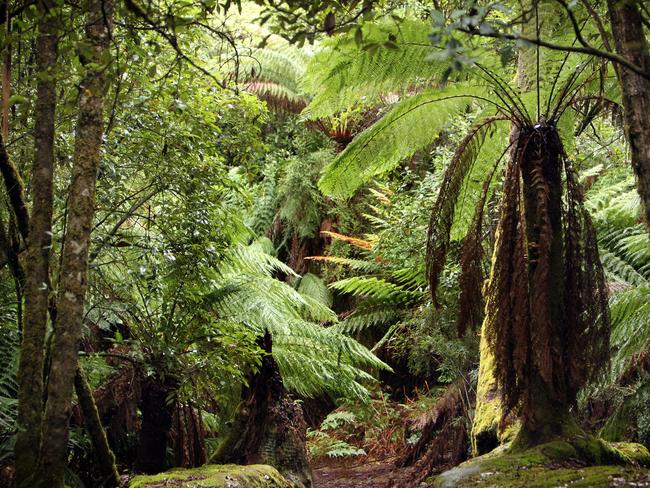Talking Point: Tasmanian forest protesters are working against best climate research
SHAWN BRITTON: North-West harvest is for iconic special timbers and high-end use

Opinion
Don't miss out on the headlines from Opinion. Followed categories will be added to My News.
The Bob Brown Foundation has acted to prevent a small selective harvest operation of Tasmania’s Special Timbers at Que River in the North-West. But their actions contradict the advice of the world’s leading scientific experts on climate change.
The “Intergovernmental Panel on Climate Change (IPCC), Special Report on Climate Change and Land” of August backs Australia’s forest industries to help fight climate change. The IPCC was appointed by the United Nations for assessing the science of climate change.
The report reinforces its fourth assessment statement on the role of sustainable forestry in climate change mitigation, which was: “A sustainable forest management strategy aimed at maintaining or increasing forest carbon stocks, while producing an annual sustained yield of timber, fibre or energy from the forest, will generate the largest sustained mitigation benefit.” This is exactly what happens in Tasmania. Every tree harvested in native forest is regenerated and the sector is working to increase carbon stocks through increasing the plantation estate and regrowing harvested native forests. We are investing in research to improve the yield to provide the ultimate renewable building material.
The small harvest the Bob Brown Foundation has been trying to prevent is in an area selectively harvested about 70 years ago, an area agreed with conservation groups under the Tasmanian Forest Agreement to be harvested to produce small quantities of iconic special timbers. The selective operation has been carefully planned to harvest about 60 trees from a 54ha coupe that contains about 25,000 trees to produce high value decorative veneer panels for a Hobart development. It will remove a small number of additional trees and low-grade wood to facilitate access to the target trees. The rest of the forest will remain intact and accessible.
Using wood products instead of more carbon intensive materials in building and construction is one of the most positive steps in the fight against climate change.
The combination of carbon sequestration in growing trees and long-term carbon storage in wood products in use represents a significant net sink and store of carbon,
Growing trees absorb carbon dioxide from the air and store it as carbon in the wood. The carbon remains stored for the life of the timber.
According to Wood Solutions, Australia’s native forests and timber plantations are net absorbers of greenhouse gases at a rate of 56.5 million tonnes of carbon dioxide per year, reducing greenhouse gas emissions by almost 10 per cent. In 2016 Australia’s forests contained almost 22,000 million tonnes of stored carbon along with 144 million tonnes of carbon stored in wood products in use.
The IPCC’s latest report says: “Sustainable forest management can maintain or enhance forest carbon stocks, and can maintain forest carbon sinks, including by transferring carbon to wood products, thus addressing the issue of sink saturation … Where wood carbon is transferred to harvested wood products, these can store carbon over the long terms.”
The alternative to using special timbers in the Hobart development is likely to be an engineered product made of plastic and imported, most likely China. To ship a plastic product instead of using a locally produced natural material is madness, and hardly a good environmental outcome but which by default is what Bob Brown protesters are promoting.
A recent survey revealed 76 per cent of Tasmanians know timber is an essential product that is renewable and environmentally friendly. The Tasmanian Government has recognised advice from climate experts and responded with Australia’s first Wood Encouragement Policy, which ensures sustainably sourced wood is fully considered in Tasmanian government procurement, particularly for new buildings and refurbishment. The product that Britton Timbers has been requested to produce by a leading architectural firm is high-quality veneer panels for the ceiling of a high-profile development in Hobart.
Veneer provides the best recovery possible, respecting the resource as it deserves.
Placement in a high-end project means it will be displayed and appreciated.
Britton Timbers makes production as sustainable as possible with the Smithton mill powered 25 per cent by its own biofuel residues and 25 per cent solar power, with the rest from the hydro-electric grid. Forestry is a sustainable system. Every tree harvested in Tasmania is replanted or regrown. The sector is working with private landowners to find more area to plant trees. The processing sector has teamed with the University of Tasmania and Sustainable Timber Tasmania on nearly 20 years of research into development of hardwood products from plantation species. Demand for timber is expected to quadruple by 2050. The Federal Government has a policy to plant a billion trees by 2030. These will need to go onto private land, because Tasmania’s public forests are regenerated to full capacity.
Planning for the harvest in the North-West began 10 years ago. The Forest Practices Code, overseen by the independent Forest Practices Authority requires detailed searches to ensure flora and fauna are protected and essential habitat retained.
The Bob Brown Foundation is not on the same page as climate experts, but if we are to take up the fight against climate change, we need to follow the best advice, that timber is The Ultimate Renewable Building material.
Now is a time for the community needs to work together for the climate. I think we are all trying to do that, but it doesn’t help to confuse people and have them misplace their energies.
Shawn Britton is managing director of Britton Timbers.


